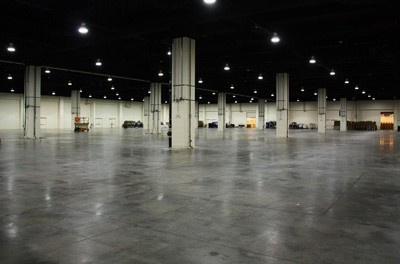It is obvious why American discovery must necessarily be bigger than discovery anywhere else. Everything else is bigger here and it is perhaps a point of honour – there would be a sense of failure if any other country had bigger discovery exercises than America.
 Take the rain, for example. It was pouring down when I last left the US, after CEIC in Orlando in May. We could barely see the car in front as we drove to the airport. That same storm seemed to have reached Washington today, as Nigel Murray of Trilantic and I drove towards the Gaylord National Resort in Washington, the venue for ILTA09.
Take the rain, for example. It was pouring down when I last left the US, after CEIC in Orlando in May. We could barely see the car in front as we drove to the airport. That same storm seemed to have reached Washington today, as Nigel Murray of Trilantic and I drove towards the Gaylord National Resort in Washington, the venue for ILTA09.
Like its twin in Dallas which was ILTA’s venue last year, this place is enormous. I spent the first hour or so exploring its vastness. It is not that there is nobody here. As its name implies, the Gaylord is a resort, and, for the weekend least, there are a lot of families here. There are two wedding parties going on – I can guess that they are separate parties because their respective guests are stunningly turned out in what appear to be themed uniforms, pale green silk for one and deep red and white for the other. Do only beautiful people go to weddings here or is there something about weddings which makes everyone look attractive? This is another of these “which came first” questions, rather like the ones which arise about the size of document populations – did the technology for document creation and storage develop to meet a need for more documents, or do we create more documents because the technology exists?
The conference area is empty. Soon the exhibitors will start to put up their booths in the warehouse-sized exhibit halls and delegates will start to arrive. Snatches of overheard conversation show that some are here already (unless, which I suppose is possible, everyone in this country talks about electronic discovery). No one I know has arrived yet, although everybody I have ever known could be here somewhere and be missed.
The Gaylord in Dallas has a rugged Wild West theme, with wooden swing doors on the bars, what appear to be bullet holes in artfully cracked plaster and a notice on the door asking the clientele to leave their handguns outside. There is no such notice here, so handguns are presumably allowed (we now have so many notices banning things in England that we are coming to assume that you are allowed to do anything not expressly prohibited). This place is rather more polished, with a grand piano tinkling in the bar and marble everywhere.
 The courtyard here is, I suppose, a replica of the old quarter of some upmarket suburb, with a clapboard house and ball finials on the columns, all in a vast glass structure which is reminiscent of Heathrow’s Terminal 5 where I was this morning. The only thing which really jars here, and could make me murderous by the end of the week, is the pervasive canned music – seven minutes of slow, sloppy sax playing or whatever under which somebody has stuck a drum machine beat which almost, but not quite, matches the rhythm of the instrument.
The courtyard here is, I suppose, a replica of the old quarter of some upmarket suburb, with a clapboard house and ball finials on the columns, all in a vast glass structure which is reminiscent of Heathrow’s Terminal 5 where I was this morning. The only thing which really jars here, and could make me murderous by the end of the week, is the pervasive canned music – seven minutes of slow, sloppy sax playing or whatever under which somebody has stuck a drum machine beat which almost, but not quite, matches the rhythm of the instrument.
There is a tendency in England to assume that what happens in America will reach us soon. If that is so, we had better start building our hotels on the scale of the Gaylord just to allow people to pass in the corridors. I got a glimpse of one of the causes of obesity this evening, when I went to a restaurant here which allows you to eat as much as you can. I am generally reasonably restrained about my food, so it was interesting to see my own reaction when I was going to part with a fixed amount however much or little I ate. I did not consciously approach my meal with the aim of getting value for my $32 but I reckon, in retrospect, that I ate half as much again as I normally would.
What does all this do for a lawyer in London EC4 or Nottingham? There is, no doubt, a trite parallel to be drawn about scale and budgets suppressing judgement; there is perhaps a political point to be made – if eat-all-you-can-carry menus were common in England, then New Labour would ban them to save us from ourselves. I could make both points without crossing the world to Washington.
The tagline for this year’s ILTA Conference is Leading Technology | Optimising Value. Technology suppliers sometimes launch new products at ILTA and, this year, one can expect much of it to be aimed at optimising value. “Value” connotes ratios rather than absolutes and should scale up or down. When that exhibition hall is full, we will be able to catch up with a lot of new technology in a short time. I will go to those sessions whose descriptions imply universal themes. There is one on Wednesday, for example, about early case assessment, one on ethics and the judicial perspective, and one on strategies of cost control and cost recovery. The panellists include some world-class names of both users and suppliers, and one only needs to carry away one nugget of recurring value from each to justify being there.
I have said before that my primary motive in coming here is discussion with people who know what they are talking about. This is not simply a matter of exchanging news and ideas but of evolving new ways to encourage wider take-up. A lot of the marketing in this industry, as in any other, is like the music on the seven minute loop with the repetitive and slightly off-set drum machine. That combination of syrupy blandness and toe-curling inappropriateness will at best be ignored and at worst incite strongly negative thoughts. To those of us immersed in this industry, the idea of using electronic means to control and electronic documents may seem too obvious to discuss – so we usually talk about other things. One of my key interests at the moment, as you may have gathered, is finding different ways of showing what all this technology can do. One can sit down and have boardroom-type discussions, and occasionally I do. The best ideas, however, evolve in discussions over a beer in a place like this.


